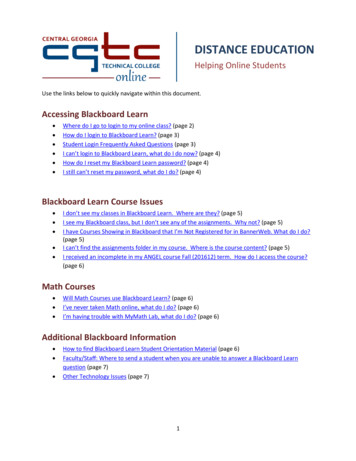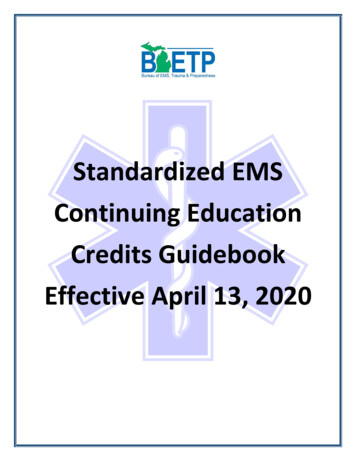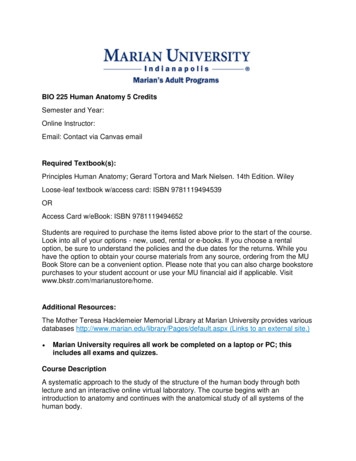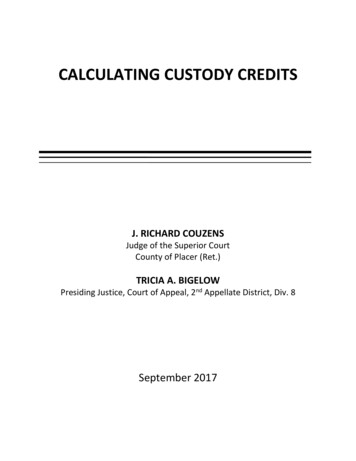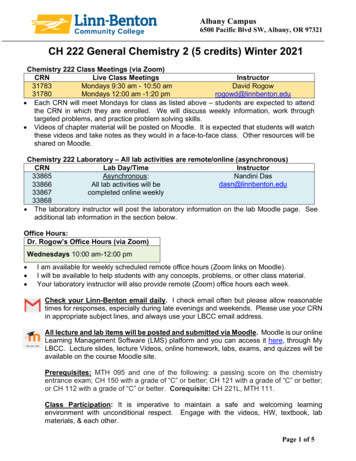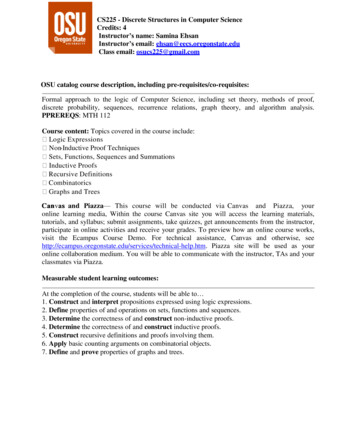
Transcription
LEARN DEBITS AND CREDITSWritten byJohn Gillingham, CPA
LEARN DEBITS AND CREDITSCopyright 2015 by John GillinghamAll rights reserved. This book or any portion thereof may not bereproduced or used in any manner whatsoever without the express writtenpermission of the publisher except for the use of brief quotations in a bookreview.
TABLE OF CONTENTSIntroduction . 6More Resources . 7Accounting Play – Debits & Credits . 7Accounting Flashcards . 7Free Lessons on Podcast and Downloads . 8Intro to Debits and Credits . 9Debits and Credits Accounting System . 9The Double Entry System .11Different Account Types.12Debits and Credits Increases and Decreases .15Increases and Decreases .15Debits and Credits by Account .16Assets.16Expenses .17Liabilities .19Equity .20Revenue .22T-Accounts .23Debits and Credits Entries .25Journal Entries .25Example Accounting Entries .28Memorization .29Contra Accounts.31Trial Balance Presentation .32Summary .34Practice set 1: Yo Company .38Blank AJEs .38Blank T-accounts with Account Titles .40Blank Balance Sheet and Income Statement .41AJE Answers .42
LEARN DEBITS AND CREDITST-account Answers .44Balance Sheet and Income Statement Answers .45Blank T-accounts with No Titles .46Blank Templates .471 T-account (Mr. T) .472 T-accounts (T-Couple) .483 T-accounts (The Famous Accounting Equation).492 T-accounts (The Income Statement) .509 T-accounts.51Example Financial Statements .52Balance sheet example .52Income statement example .53Statement of Shareholders’ equity example .54Statement of Cash Flows.55Adjusting Journal Entries.56Trial Balance.575
LEARN DEBITS AND CREDITSINTRODUCTIONBefore you do anything – Download your exclusive copy of this book in ccountingplay.com/bonus/).Hi – I am John, CPA : ) . I have an accounting firm and have a huge passionfor teaching financial accounting – especially the introductory andintermediate course. It makes me sad that so many students drop the classbecause they never understand debits and credits. This stuff is not hard,but just takes time. Once you “get it” it will let you focus on the point ofaccounting, which to me, is all about business.Does this look familiar?6
LEARN DEBITS AND CREDITSMORE RESOURCESMaking apps is super expensive and risky. I have worked really hard tomake learning more fast and fun. So please check out the apps and if youcan afford it, upgrade so you can get the paid content and show some loveat the same time. Please, please, please also provide feedback because I getvery little feedback and I want to design my next projects around YOU notwhat I think YOU might need. Thanks!ACCOUNTING PLAY – DEBITS & CREDITS(for iPhone and iPad) Free to try and free learning section Learn Debits and Credits in a game format It’s a Game: ) – It’s fast – It’s soo cooool Has a learning section https://appsto.re/us/Naa32.iACCOUNTING FLASHCARDS(for iPhone and iPad) Free to try Over 100 illustrated flashcards 19 micro financial accounting lessons Audio narration Flashcards in English, Chinese, & Spanish https://appsto.re/us/rIxNZ.i7
LEARN DEBITS AND CREDITSFREE LESSONS ON PODCAST AND DOWNLOADS Get all audio lessons in the app, free on The Accounting Play Podcast Downloads and more atAccountingPlay.com This PDF:http://Accountingplay.com/Downloads/8
LEARN DEBITS AND CREDITSINTRO TO DEBITS AND CREDITSAudioVideoDEBITS AND CREDITS ACCOUNTING SYSTEMDebits and credits form the foundation of the accounting system. Themechanics of the system must be memorized. Once understood, you will beable to properly classify and enter transactions. These entries make up thedata used to prepare financial statements, such as the balance sheet andincome statement. While software has simplified entering dailytransactions, debit and credit entries are always recorded in thebackground.9
LEARN DEBITS AND CREDITSLearning about debits and credits requires a combination of memorizationand application of the terms. Memorization of account types, as well asincrease and decrease rules, is a good first step. Next, you must understandhow transactions are recorded into the system. The goal is to be able tomanually record and adjust transactions using debits and credits. Use allresources: lessons, flashcards, rap memory aid, practice sets, video, andAccounting Play – Debits & Credits game for iPhone and iPad. For video anddownloads, please go to AccountingPlay.com.Every accounting transaction involves at least one debit and one credit. Thesum of debits and the sum of credits for each transaction and the total ofall transactions are always equal. This equaling process is referred to asbalancing. A list of all transactions appears in the general ledger and thesum of assets will equal the sum of liability and equity accounts on thebalance sheet. Transactions are manually entered into the accountingrecord using adjusting journal entries (AJEs) which present debits beforecredits. Accountants may use a trial balance to summarize all accounts indebit and credit format so they can be further adjusted with AJEs.Memorize rule: debits always equal creditsMemorize rule: debits before credits10
LEARN DEBITS AND CREDITSTHE DOUBLE ENTRY SYSTEMThe process of recording transactions with debits and credits is referred toas double entry accounting, because there are always at least two accountsinvolved. The result of using double entry accounting ensures that everytransaction is classified and recorded.The double entry system requires us to pick at least two accounts to recorda transaction. Let's say a business receives 1,000 cash. To record thetransaction, the cash account is increased 1,000. As a rule we need at leastone other account to record the activity. The other account will helpexplain the source and purpose of the transaction. Cash can come from avariety of sources, such as: revenue, loans, investments, investors, or cashback from returning an item. In this example, the business was paid cashfor services performed. The revenue account therefore also increases 1,000 the same time cash increases 1,000.The double entry system is used to categorize all transactions in theaccounting record. Let's say 200 cash is paid from the bank. Cash isdecreased 200, which explains where the money came from. Anotheraccount is required to explain the destination and purpose of thetransaction. Cash is used for a variety of things: equipment, investments,loan payments, expenses, and stock repurchases. In this example, thebusiness paid a 200 phone bill in cash. The telephone expense accounttherefore increases 200. The combined entry will be to increase telephoneexpense and reduce cash for the same amount. The increase and decreasewill be expressed on the accounting record as one debit and one credit.11
LEARN DEBITS AND CREDITSThe double entry system categorizes transactions using five account types:assets, liabilities, equity, income, and expense. The same account may beused if there is an increase and a decrease of the same category, such as acash transfer. Assets, liabilities, and equity make up the balance sheet andform the accounting equation: Assets (A) Liabilities (L) Equity (E).Revenue and expenses make up the income statement and can generallybe expressed as Revenue – Expenses Income or Loss.DIFFERENT ACCOUNT TYPESEvery account is classified in one of fivedifferent classifications: assets, liabilities,equity, revenue, and expense. Each account isincreased or decreased with a debit or credit,depending on the classification.Assets: cash and cash equivalents, accountsreceivable, inventory, prepaid expense,investments, property, plant, and equipment,intangible assets,12
LEARN DEBITS AND CREDITSContra assets: allowance for doubtful accounts, accumulated depreciation,accumulated amortizationLiabilities: accounts payable, notespayable, accrued expenses, deferredrevenue, long-term bonds payableContra liability: bond discountEquity: common stock, additional paid-incapital, retained earningsContra equity: treasury stock13
LEARN DEBITS AND CREDITSRevenue: sales revenue, interest income,investment incomeExpense: selling, general, andadministrative, interest, repairs,depreciation14
LEARN DEBITS AND CREDITSDEBITS AND CREDITS INCREASES AND DECREASESINCREASES AND DECREASESAudioVideoThe debit and credit rules used to increase and decrease accounts wereestablished hundreds of years ago and do not correspond with bankingterminology. Careful, as banks refer to debit cards, credit cards, accountdebits, and account credits differently than the accounting system. Cash forexample, increases with a debit.The accounting equation diagram visually displays how accounts increaseand decrease. The debits and credits diagram condenses this information.Balance sheet accounts:Assets: increase with a debit anddecrease with a creditLiabilities: decrease with a debit andincrease with a creditEquity: decrease with a debit andincrease with a creditIncome statement accounts:Revenue: decrease with a debit andincrease with a creditExpenses: increase with a debit anddecrease with a credit15
LEARN DEBITS AND CREDITSDEBITS AND CREDITS BY ACCOUNTBellow, assets and expense accounts are presented first to aid beginnerswith memorization. Both these accounts increase with a debit and decreasewith a credit.ASSETSAsset increases are recorded with a debit.First step to memorize: “Debit asset up,credit asset down.” Asset accounts,especially cash, are constantly moving upand down with debits and credits. Theending balance for an asset account willbe a debit.Increases and decreases of the sameaccount are common with assets.Transfers from one cash account toanother is recorded as a reduction of onecash account and increase to another cashaccount. An example of this is the transferof cash from savings to checking. In theaccounting record, the checking account is16
LEARN DEBITS AND CREDITSincreased with a debit and the savings account is decreased with a credit.Note that these terms are exactly opposite of how the bank will refer tothem!Increases and decreases of the same account type are common with assets.An example is a cash equipment purchase. The equipment account willincrease and the cash account will decrease. Equipment is increased with adebit and cash is decreased with a credit.Let’s say a candy business makes a 9,000 cash purchase of candy to sell inthe store. Cash in the bank is going to go down and candy will arrive at thestore. Candy inventory is going to increase 9,000 with a debit and the cashaccount will decrease 9,000 with a credit.Memorize rule: debit asset up, credit asset downEXPENSESExpense increases are recorded with a debit and decreases are recordedwith a credit. Transactions to expense accounts will be mostly debits, asexpense totals are constantly increasing. The ending balance for an expenseaccount will be a debit.Under cash basis accounting, expenses are recorded when cash is paid.Take the example of a cash purchase for a client lunch. Cash is going to godown and an expense goes up. Meals and entertainment expense accountis increased with a debit and the cash account is decreased with a credit.Under accrual basis accounting required by Generally Accepted AccountingPrinciples in the United States (US-GAAP), expense is recorded before cashis paid. Typically bills for items such as internet expense will be firstrecorded into accounts payable, a liability account. Accounts payable (AP)17
LEARN DEBITS AND CREDITStracks all of the bills before they are paid for in cash. Say a 500 internet billarrives for May service, but is not due until next month. The 500 internetexpense is recorded in May with a debit and a 500 AP is recorded with acredit. When the bill is paid for in cash the next month, AP will decreasewith a 500 debit and cash will decrease with a 500 credit.Expenses are almost always going to be a debit transaction, but expensescan also be decreased with a credit as needed. Let’s say a business pays agardener 1,000 cash for maintenance. Maintenance expense increases 1,000 with a debit and cash decreases 1,000 with a credit. Now assumethe honest gardener returns, apologizing that there was a mistake and theservices should have been 800. The gardener then returns 200 of cash tothe business as a refund. To record this transaction, cash is increased 200with a debit and expense is decreased 200 with a credit. The effect of thistransaction is to reverse 200 of expense.Expenses such as depreciation and amortizationare typically recorded with journal entries, due toaccounting software limitations. These expensesare recorded to show the decline in value ofcertain assets over time and do not affect cash.Depreciation expense is recorded with a debit andthe other side of the transaction is recorded toaccumulated depreciation with a credit.Amortization expense is also recorded with adebit and the other side of the transaction isrecorded to accumulated amortization as a credit.Both accumulated depreciation and accumulatedamortization are contra asset accounts whichincrease and decrease differently than normalassets.Memorize rule: debit expense up, credit expense down18
LEARN DEBITS AND CREDITSLIABILITIESLiability increases are recorded with a credit and decreases with a debit.This is the opposite debit and credit rule order used for assets. Bydefinition, the rules of debits and credits mirror the accounting equation:Assets Liabilities Equity. In debit and credit terms, Asset debits Liabilitycredits Equity credits. The ending balance in liability accounts willtherefore be credits so that the equation will balance.The most common liability to a business isaccounts payable (AP), which comprises ofmoney owed to providers of goods andservices to the business, known as vendors.US GAAP requires accrual basis accountingthat records expenses and revenue beforecash is actually paid or received. Companieson the accrual basis accounting will recordexpenses as they are incurred. Bills foritems such as internet expense will be firstrecorded into accounts payable, a liabilityaccount. Say the internet bill for 500arrives for May, but is not due until thenext month. The 500 expense is recordedin May with a debit and a 500 payable is19
LEARN DEBITS AND CREDITSrecorded with a credit. When the bill is paid in cash next month, AP willdecrease with a 500 debit and cash will decrease with a 500 credit.Liabilities are constantly increasing and decreasing, but the ending balancewill be a credit. Take the loan payable account as an example. Assume abusiness receives cash after taking a loan of 100,000. The cash accountwill increase 100,000 with a debit and the loan account will increase witha 100,000 credit. Principal payments will reduce the loan with a debit andincrease with a credit.Memorize rule: debit liability down, credit liability upEQUITYEquity increases are recorded with a credit and decreases with a debit. Thisis the opposite debit and credit rule order used for assets. By definition, therules of debits and credits mirror theaccounting equation: Assets Liabilities Equity. In debit and credit terms, Assetdebits Liability credits Equity credits.The ending balances in equity accountswill therefore be credits so that theequation will balance.The first accounting transaction a businesshas is typically an increase to cash and anincrease to an equity account. Let’s say abusiness starts by issuing stock inexchange for 1,000,000 cash receivedfrom an investor. Cash increases with a 1,000,000 debit and equity increaseswith a 1,000,000 credit.20
LEARN DEBITS AND CREDITSProfits and losses are recorded in the retained earnings equity account,typically on a quarterly and yearly basis. Just like common stock, theaccount increases with a credit and decreases with a debit. Retainedearnings is not the same as cash, because it is based on net income or loss,not cash received. Assume a business has 950,000 net income, reportedon the income statement. Retained earnings at the end of the accountingperiod will be increased with a credit of 950,000. The corresponding 950,000 debit is made to the income summary account, which closes theincome statement for the period. The closing records income statementactivity for the period on the balance sheet, using retained earnings. Notethat the closing of the income summary is a process largely automated byaccounting software.Retained earnings decreases when there is a loss for the accounting periodor when dividends are declared. Assume a business has an 80,000 loss forthe year. Retained earnings will be reduced with an 80,000 debit and theincome summary closed with an 80,000 credit.The declaration of dividends reduces retained earnings. The entry reducesretained earnings with a debit and increases dividends payable liability witha credit. Later when the declared dividends are paid to shareholders, thedividends payable liability will decrease with a debit and cash will decreasewith a credit.Memorize rule: debit equity down, credit equity up21
LEARN DEBITS AND CREDITSREVENUERevenue increases are recorded with a credit and decreases are recordedwith a debit. Transactions to the revenue account will be mostly credits, asrevenue totals are constantly increasing. The ending balance for a revenueaccount will be a credit.Under cash basis accounting, revenue isrecorded when cash is received. Take asmall coffee shop that sells a 5 latte forexample. When the customer pays in cash,cash increases and so does revenue. Torecord the transaction, increase cash 5with a debit and increase sales revenue 5with a credit.Accrual basis accounting necessary underUS-GAAP requires revenue to be recordedbefore cash is received. Typically revenueis earned when an item ships and the saleis recorded in accounts receivable.Accounts receivable (AR) is an assetaccount that tracks the amounts owed tocustomers until cash is paid. Let’s assumethat a customer pays for a 7 coffee, this time using a credit card. Cash isnot instantly received from the credit card company, so the sale is a 7increase to AR and a 7 increase to sales revenue. When the cash iscollected from the credit card company, cash will increase 7 with a debitand AR will decrease 7 with a debit.Revenue is almost always going to be a credit transaction, but revenue canalso be decreased with a debit as needed. A business might need to reducethe revenue account if a sale is returned. Let’s say someone thought a 722
LEARN DEBITS AND CREDITScoffee paid for in cash was a complete waste of money and demands arefund. To process a cash basis refund the café would decrease salesrevenue with a debit and decrease cash with a credit when they refund thecustomer.Memorize rule: debit revenue down, credit revenue upT-ACCOUNTST-accounts may be used to visually represent debit and credit entries. Thisis visually represented as a big green T in Accounting Game - Debits andCredits, available for iPhone and iPad. The left side of the T-account is adebit and the right side is a credit. Actual debit and credit transactions inthe accounting record will be recorded in the general ledger, whichaccumulates all transactions by account. T-accounts help both students andprofessionals understand accounting adjustments, which are then madewith journal entries.Memorize rule: debits on the left and credits on the rightDebits and credits follow the logic of the accounting equation: Assets 23
LEARN DEBITS AND CREDITSLiabilities Equity. At all times, Asset debits Liability credits Equitycredits.Memorize rule: Assets Liabilities EquityMemorize rule: the sum of all assets will equal the sum of liabilities equityEach account generally will have an ending debit balance or credit balance,depending on the account type. These ending balances by account type canbe referred to as the natural balance. Assets and expenses both increasewith a debit and therefore have debit ending balances. Liabilities, equity,and revenue increase with a credit and therefore have credit endingbalances. Retained earnings may have a debit balance due to incomestatement losses.Memorize rule: assets and expenses increase with a debit and generallyhave ending debit balancesMemorize rule: liabilities, equity, and revenue increase with a credit andgenerally have credit ending balances24
LEARN DEBITS AND CREDITSDEBITS AND CREDITS ENTRIESAudioVideoJOURNAL ENTRIESEach transaction in accounting has a debit and credit side. Yet, the user ofaccounting software can be unaware of this because the entries are mostlyautomatic. Journal entries are the mechanism of how accountingtransactions are manually entered using debits and credits. Every journalentry first displays debits and then credits for the purpose of consistentpresentation. But as long as the total debits and credits are equal, the entrywill still work regardless of order. Journal entries will have a date that thetransaction takes place, description, and amounts.25
LEARN DEBITS AND CREDITSJournal entries are often referred to as adjusting journal entries, or AJEs, asthey adjust the accounting record. Adjusting journal entries arecommonplace to make corrections. Entries are also made for non-cashtransactions, such as depreciation and amortization.Journal entries can incorporate more than one account, as long as the sumof debits equals the sum of credits. For example: Recording a cash assetsale of depreciated machinery for a gain would require increasing cash witha debit, removing the accumulated depreciation with a debit, removing theasset with a credit, and increasing gain on sale of asset with a credit. Entriescan quickly become complicated, but make performing adjustmentspossible.26
LEARN DEBITS AND CREDITSMemorize rule: journal entries first record debits, then creditsMemorize rule: journal entry debits credits27
LEARN DEBITS AND CREDITSEXAMPLE ACCOUNTING ENTRIESTransfer 15,000 from savings to checkingEntries:Increase cash in checking: debit cash in checking 15,000Reduce cash in savings: credit cash in savings 15,000Receive 1,000,000 from issuing common stockEntries:Increase cash: debit cash 1,000,000Increase common stock: credit common stock 1,000,000Make 300 credit saleEntries:Increase accounts receivable (AR): debit AR 300Increase revenue: credit revenue 300Collect cash for 300 credit saleEntries:Increase cash: debit cash 300Decrease accounts receivable (AR): credit AR 300Receive 250 internet bill for May, the last day of May, but not due untilJuneEntries:Increase internet expense: debit internet expense 250Increase accounts payable (AP): credit AP 250Pay 250 internet bill for May in cash at the end of JuneEntries:Decrease accounts payable (AP): debit AP 250Decrease cash: credit cash 25028
LEARN DEBITS AND CREDITSRecord 7,000 of depreciation expenseEntries:Increase depreciation expense: debit depreciation 7,000Increase accumulated depreciation: credit accumulated depreciation 7,000Receive 1,000 of cash revenue and pay 200 cash for meals andentertainment(assume no beginning balances in the accounts)Entries:Increase cash: debit cash 1,000Increase revenue: credit revenue 1,000Increase expense: debit meals and entertainment 200Decrease cash: credit cash 200Result:Ending cash: 800 debitEnding revenue: 1,000 creditEnding expense: 200 debitEnding debits: 800Ending credits: 800MEMORIZATIONTypical debits & credits explanation diagrams start with assets. Assetsincrease with a debit. Expenses also increase with a debit. Therefore, assetsand expenses both increase with a debit and decrease with a credit.Liability, equity, and revenue decrease with a debit and increase with acredit.29
LEARN DEBITS AND CREDITSDebits & Credits Mnemonic (memory aid)You may use this Debits & Credits Mnemonic to memorize how to increaseand decrease accounts using debits and credits.Debit cash up, credit downOther side now, flip aroundI got revenue credits, expenses as debitsDebit left, credit right - balance sheet so tightDebits & Credits Mnemonic ExplainedDebit cash up, credit downAssets increase with a debit and decrease with a creditOther side now, flip aroundThe other side of the balance sheet is liability and equity, which increasewith a credit and decrease with a debit, the opposite or “flip” of assetsI got revenue credits, expenses as debitsRevenue increases with credits and decreases with debitsExpense increases with debits and decreases with credits30
LEARN DEBITS AND CREDITSDebit left, credit right - balance sheet so tightDebits are on the left side of the T-account and credits are on the right sideof the T-accountTotal debits always equal total credits on the balance sheetCONTRA ACCOUNTSContra accounts are exceptions to the rule and will increase and decreasein the opposite manor as regular accounts. Asset contra accounts include:allowance for doubtful accounts and accumulated depreciation. Assetcontra accounts increase with a credit and decrease with a debit.There are also infrequently used contra equity and contra liability accountswhich increase and decrease in the opposite manor as regular equity andliability accounts. Treasury stock is a contra equity account that increaseswith a debit and decreases with a credit. Bond discount is a contra liabilityaccount that increases with a debit and decreases with a credit. These aregenerally advanced accounting topics and are only relevant for largepublically traded companies.Contra accounts serve to indirectly reduce regular accounts. Theaccumulated depreciation contra account increases over time asdepreciation expense is recorded. Let’s say a business purchases a truck for 50,000 cash. Truck asset increases 50,000 with a debit and cashdecreases with a 50,000 credit. In order to show the decrease in valueover time, depreciation expense is recorded. Take for example,depreciation expense recorded at 10,000 a year. Instead of directlyreducing the truck asset value, depreciation expense will be increased witha debit and accumulated depreciation increased with a credit. The asset ispresented as a positive debit and the accumulated depreciation as a creditthat appears as negative. After recording the depreciation expense, thetruck asset account is 50,000 and the depreciation contra asset account is31
LEARN DEBITS AND CREDITS (10,000). When combined, the net asset value of the truck will be 40,000(asset - accumulated depreciation). The original
May 01, 2015 · for teaching financial accounting especially the introductory and – intermediate course. It makes me sad that so many students drop the class because they never understand debits and credits. This stuff is not hard, but just takes time. Once you “get it” it will let you focus on the point of

